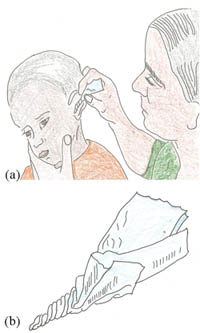14.4.2 Dry a discharge from the ear by wicking
To teach a mother how to dry the ear by wicking, first tell her it is important to keep an infected ear dry to allow it to heal. Then show her how to wick her child’s ear.
As you wick the child’s ear, tell the mother to:

- Use clean, absorbent cotton cloth (see Figure 14.3) or soft strong tissue paper for making a wick. Explain to her that she must not use a cotton-tipped applicator, a stick or flimsy paper as these will fall apart in the ear
- Place the wick in the child’s ear until the wick is wet
- Replace the wet wick with a clean one
- Repeat these steps until the wick stays dry. Then the ear is dry.
Observe the mother as she practises. Give feedback. When she is finished, give her the following information:
- Wick the ear three times daily
- Use this treatment for as many days as it takes until the wick no longer gets wet when put in the ear and no pus drains from the ear
- Do not place anything (oil, fluid, or other substance) in the ear between wicking treatments. Do not allow the child to go swimming. No water should get in the ear.
Before the mother leaves, ask checking questions to ensure that she knows how to wick the child’s ear at home.
14.4.1 Treat eye infection with tetracycline eye ointment
